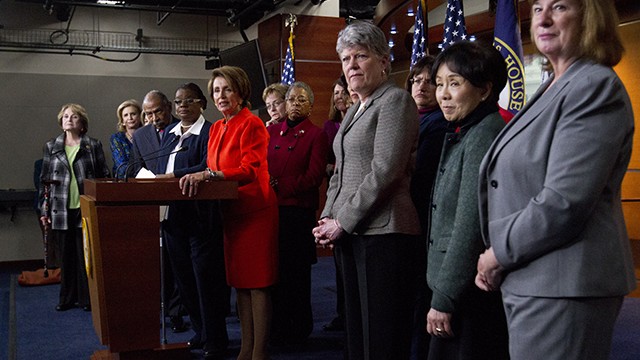
In the wake of last November’s election, many pundits credited Obama’s victory to the record number of single women who turned out and voted for him. Nearly a quarter of all voters were single women and they voted for Obama over Romney by an overwhelming margin of 36 points. Add to that the unprecedented number of women elected to serve in the 213th Congress and many were calling the 2012 election a “historic moment for women.”
Last week, some of that political power made an impact in the halls of Congress. In a surprising turn of events, the House of Representatives renewed the Violence Against Women Act (VAWA) and sent it to the president to sign. The law, first enacted in 1994, had been renewed twice without controversy, but during the last Congress, House Republicans objected to a new version, passed by the Senate, that included gay, transgender, immigrant and Native American women in the language of the bill.
At the start of the 113th Congress, many felt pessimistic about the VAWA’s chances of being renewed. It looked like the bill would continue to languish in the House. But on Tuesday, Republican leaders — likely in a move to gain ground with women voters — agreed to allow a vote on the Senate version of the bill and it passed the Republican-dominated House by a vote of 286-138.
Those who thought the bill would remain stalled forever had good reason to feel that way. Despite huge advances over the last century in women’s rights, bills designed to help women have not had the greatest track record in American politics.
Perhaps the passage of the VAWA signals a change in course — as Anne Hathaway says, a girl can dream — but let’s not get ahead of ourselves. Here’s a look back at five pieces of legislation that would have made life very different for women had things turned out differently. (Thanks to the National Women’s Law Center for their research help.)
The Black Bill: In 1933, during the depths of the recession, then-senator and future Supreme Court Justice Hugo Black proposed a law to increase employment by limiting the work week to 30 hours. In addition to creating jobs, Black’s bill would have helped parents to more evenly distribute the burden of raising children while working, increasing the possibility of both a husband and a wife holding jobs. Even today, political economist Gar Alperovitz, who calls for a 25-hour work week, argues that a shorter work week would increase workplace equality because, when a family has a child and both parents work 40-hour weeks, the woman is usually the parent who leaves work or works part-time in order raise the child. Eventually, Black’s bill, amended to a 40-hour work week, passed into law as the Fair Labor Standard Act of 1938.
The Comprehensive Child Development Act: Introduced in 1971, the bill would have allocated federal money to fund a national day care system to improve early education nationwide and to decrease the burden on single working parents. It passed the Senate 63 to 17, but President Nixon vetoed it. “The federal government should not be in the business of raising America’s children,” Pat Buchanan later said — he was on Nixon’s staff at the time, and helped write the veto message. Had the bill become law “it would have truly been a step toward public support for childcare for the poor, but also for middle income people,” explained Emily Martin, the vice president and general counsel for the National Women’s Law Center.

Moyers & Company’s own executive editor, Judith Davidson Moyers, traveled to a number of states speaking in favor of the Equal Rights Amendment in the early 1980s.
The Equal Rights Amendment: The ERA made equality between the sexes a constitutional right. The Amendment was first written in 1923 by suffragettes, but gained traction during the Women’s Movement and in 1972 passed both houses of Congress and was signed by the president. It went on to the states for ratification where it encountered substantial opposition. Some men thought that equality in all forms was not in women’s best interest. “A really common concern,” Executive Editor of Moyers & Company Judith Davidson Moyers said, “was, ‘if women have the Equal Rights Amendment, they will lose the protection of men.’ In the South, you heard, ‘We hold our women on a pedestal. We want them to be held above the fray.'” Stephanie Coontz, who teaches women’s studies and history at Evergreen State College, remembers other objections: “Laughably, the two main arguments against it were the prospects of unisex toilets and women in the military,” Coontz wrote in an email. Untimately, fifteen states failed to ratify the amendment and in 1982 it expired.
Dropping the Hyde Amendment: The Hyde Amendment, in its current form, prohibits federal funds from being used for abortions except in cases of rape, incest or endangerment to the life of the mother. The law’s impact is limited almost entirely to poor women — Henry Hyde (R-IL), the conservative congressman who first proposed the amendment, acknowledged this reality during a Medicaid funding debate in 1977, when he told his colleagues, “I certainly would like to prevent, if I could legally, anybody having an abortion: a rich woman, a middle-class woman or a poor woman. Unfortunately, the only vehicle available is the… Medicaid bill.”
The Hyde Amendment is not a permanent law — it’s a rider to the annual Health and Human Services appropriations bill. That means that every year, the amendment must be applied to the appropriations bill, and that every year there is the possibility to change the amendment’s language or to get rid of it entirely. In 1993, the appropriations bill made it through the Senate and arrived on the House floor without the amendment in it. For some advocates, it looked like the bill might pass without it, but Hyde — who was still a congressman — agreed to add the rape and incest exceptions that he had opposed for decades and, with those additions, was able to rally enough anti-abortion Democrats for the bill to pass with the amendment.
The Paycheck Fairness Act: The Paycheck Fairness Act built on the Equal Pay Act of 1963 by expanding and closing loopholes in the 1963 law. Importantly, the Paycheck Fairness Act would increase protection for women filing discrimination lawsuits and prevent employers from retaliating against employees who discuss salaries — making discriminatory payscales more obvious. The bill was filibustered to death in the Senate during both the 111th and the 112th Congresses. It was reintroduced again in 2013, but the National Women’s Law Center’s Emily Martin doesn’t hold high hopes for it during the 113th Congress either. “It’s unlikely to imagine it passing this House,” she said. “But we believe it eventually will pass and it eventually must pass.”

